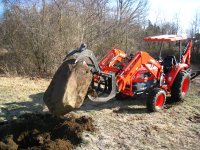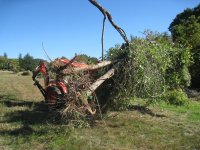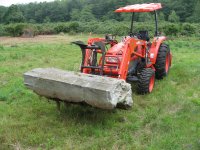Actually we aren't. I am well aware of what using a rear ballast means. I never said the CT120 was a lawnmower either.
What I said was the rating given for tractors is best case scenario with a rear ballast on level ground. By the time you back out the weight of the QA, and grapple as well as take into account a safety factor for uneven terrain there is not much capacity left and when you do that the weight of the load as well as the majority of the tractor is all on the little front axle which was not designed for that.
I had a CT-450 and with a heavy rear blade I could pick up small round bales, likely 1,000 pounds or less and even then there was only a couple hundred pounds on the rear tires, everything else was on the front axle. If you are driving and that side goes into a dip or sinks into mud it is very unstable.
I would guess that the OP is correct in thinking he will be able to safely carry around 400-500 pounds in a grapple.
Out of curiosity how do you adjust your ballast? Is that like yelling for junior to come stand on the brushhog so you can move this load lol.
1) I never said YOU didn't know what ballast was about. You had however raised ballast in a discussion that was focused on lifting power. I tried to clarify for the OP.
2) One plans ballast needs ahead of time. Not rocket science. If you find during a lift that you misjudged and need more ballast then stop what you are doing and fit some different 3PT implement to raise ballast. As is clearly documented in any tractor owner's manual, ballast must be added when using the FEL. On my CK20 I had beet juice in the rear tires and I never lifted anything significant without either a bush hog (about 500lbs) or a backhoe (about 700-800lbs) extending from the rear of the tractor. On rare occasion I have extended the BH boom with a bucket full of dirt to maximize ballast leverage. I wouldn't travel more than a short distance slowly with such a set up.
3) I could raise the rear wheels even with the bush hog and rimguard if I stuck the grapple under a fresh stump and curled/lifted. No biggie. Just set the tractor back down and work to loosen up the stump more by ripping side roots before trying again. I removed dozens of stumps that way. Perfectly safe. The loads on the front axle in such a situation are smooth and progressive not jerky or dynamic and the engineers built the front axles to manage whatever the loader could deliver.
4) I have a tractor almost identical to your CT450, the Kioti DK40se. I assure you it can lift more than 1000lbs and move it safely. Photo below shows a granite boulder that by volume weighed between 2000-2500lbs. I didn't try to lift it higher than seen in the photo and I lowered it almost to the ground before moving it. I used a BH for ballast. The rear felt light but as I was only moving 100 feet or so to the side of the field I just moved slowly and finished the job. I didn't see whether I could lift it higher as I had no reason to but I'm pretty sure I was about maxed out on lift and recognized it would be stupid to raise the tractor center of gravity unnecessarily when lifting such a load.
5) DK40 also lifted a 7ft section of Jersey barrier at about 400lbs per foot =about 2800lbs. I didn't try to lift it higher than I needed to to move it several hundred yards across a field. I recall I only had a flail mower as ballast.
6) To get back to the OP's situation, he has a CT120 which I believe has just about the same lift capacity as a CK20: a bit over 1000lbs to full height at pivot pins. A 48" bucket holds about 1/4 yard so if loaded with sand would weigh about 600-700lbs. I have lifted that much sand to near full height with a CK20 when loading a pickup truck with sand.
Bottom line: The CT120 can certainly lift more than the 400lbs in the bucket estimated by the OP. Just ballast it properly and pay attention to dynamic forces when moving (slowly!).





